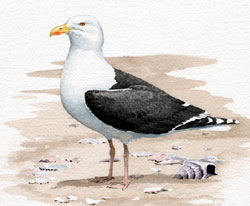Find a Bird - BBA1
Breeding Bird Atlas 1 Species Accounts
Great Black-backed Gull
Larus marinus
Egg Dates
April 18 to July 15
Number of Broods
one; may re-lay if first attempt fails.

This large, northern gull has been extending its breeding range southward since the beginning of this century. Nova Scotia was the limit in 1920, but the species continued its southerly expansion, and pioneering Great Black-backed Gulls were found nesting in Massachusetts in Salem in 1931 and on the Weepecket Islands in 1941. As Great Black-backed Gulls continued to forge south, reaching North Carolina in 1985, the population in the Commonwealth grew to 3,000 pairs by 1972 and an estimated 11,000 breeding pairs by 1984. This explosive population growth was the result of protection and abundant food sources, such as town dumps; an increase in offshore fishing; and inappropriate fish handling by processors. All indications are that the breeding population has stabilized or may be declining.
Great Black-backed Gulls can be observed in Massachusetts year-round. As the scientific name implies, this is a bird of the coast and ocean; however, during the nonbreeding season, this gull may be found well inland along with the more numerous Herring Gull. Since the Atlas period, breeding has been confirmed for a few pairs inland at the Wachusett Reservoir. In spring, they hold breeding territories by early April, with courtship and pairing later in the month. Adults are basically permanent residents. Great Black-backed Gulls are usually found nesting in mixed colonies with Herring Gulls, preferably on barrier beaches and rocky islands but also occasionally on the mainland. Aggressive and dominant to other gulls and terns, Great Black-backed Gulls crowd them from desirable nesting areas and prey on their eggs and young.
This gull has a long call that is similar to, but deeper than, that of the Herring Gull. Similarly, its kyow, kyow call note is markedly deeper and distinctive and most often heard as it soars overhead. A repeated kyow, kyow, kyow is given if an intruder goes too near the nest or young.
The nest is bulky and made of dry grasses and seaweeds. A three-egg clutch is the norm, but two or four eggs are not uncommon. In Massachusetts, the peak laying period is April 25 to May 20 (Nisbet, Drury). Pairs may renest if they lose their first set of eggs. The precocial chicks hatch after 28 to 30 days and seek shelter in nearby vegetation at 2 or 3 days of age. They fledge after about 45 days. Both parents are active in the incubation of the eggs and feeding of chicks and defend the nest site vigorously against intruders. Most pairs raise one or two young to fledging age (Nisbet).
By late summer, flocks of chocolate brown fledglings roam the shoreline adjacent to the nesting colony. In the following weeks and months, most of these young disperse southward while the adults establish a daily routine of foraging and loafing that never takes them very far from the breeding islands. Nesting birds from farther north augment the wintering population.
Map Legend and Data Summary
Atlas 1 data collected from 1975-1979


Note: locally abundant on offshore islands
Peter Trull



